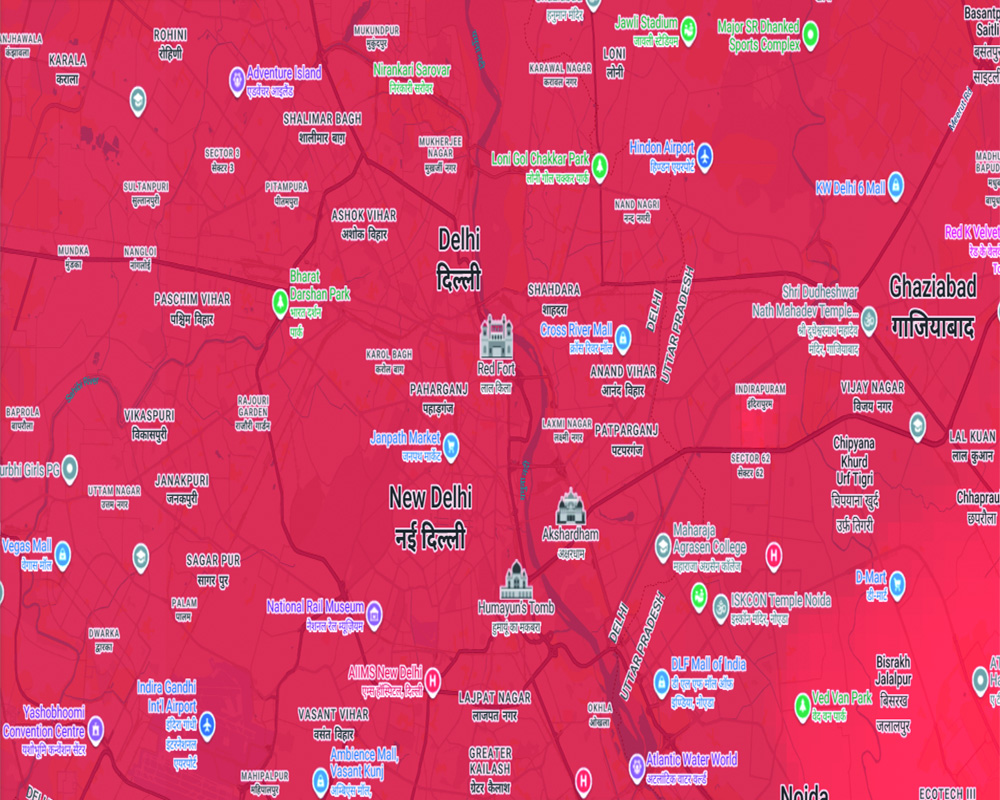Confusion prevails over the accuracy of the Air Quality Index (AQI) as Delhiites gasp for breath. While the Central Pollution Control Board (CPCB) on Monday recorded the Delhi’ AQI at 486 at 6 am marking the worst of the season, another platform, IQAir, a Swiss air quality technology company, showed Delhi’s AQI around 1,697 at 12.30 pm. It recorded 2,314 AQI at VIvek Vihar C block station, which is beyond severe, in the National Capital. An official statement issued by the Delhi Development Authority (DDA) which comes under the Lieutenant Governor Vinai Kumar Saxena also cited the AQIat 1000.
According to IQAir, the National Capital ranked at the top of the list of most polluted cities in the world. The PM2.5 concentration is recorded at 907.5 µg/m³ that is 182.5 times the World Health Organization (WHO) annual PM2.5 guideline value.
Another platform, AQICN.Org, shared real time data that showed AQI at 874 in the hazardous category. The India Meteorological Department has issued an Orange Alert due to dense fog in the city. With the city shrouded in dense fog and visibility severely reduced, flight and train operations have been disrupted, leading to delays.
As several platforms showing AQI at hazardous levels beyond the severe, the Commission for Air Quality Management (CAQM) issued a communiqué urging to refer only to the SAMEER App or the CPCB Official Website for accurate and reliable data. “These are the authorised platforms for relaying the air quality index. Please avoid relying on unofficial or unreliable sources to ensure that correct information is alone disseminated to the public,” it added.
The Air Quality Index, is a numerical scale that measures certain pollutants and their concentration to communicate the quality of air in a specific area. It also provides information on how these numbers can affect human health and the environment. When asked officials say some platforms, like IQAir, provide real-time data, while others, like the CPCB, provide a single reading for a day.One of the reasons why the data collected by different platforms is varied is due to access to air quality monitoring stations.Since IQAir is an aggregator, it uses information from government-run sensors, which are also used by the CPCB.
It also uses privately operated sensors, which may provide more localised readings.Platforms such as IQAir update the AQI of a city and its different regions much faster with real-time data, while the CPCB gives one reading which applies to the region for a day.
Due to this, the AQI in IQAir will always seem to be fluctuating as it is reacting to changes over an hourly basis.Typically, AQI is calculated based on certain pollutants, such as PM2.5 (particulate matter less than 2.5 microns), PM10 (particulate matter less than 10 microns), ozone, nitrogen dioxide, sulphur dioxide, carbon dioxide, and a few others.
According to IQAir, Delhi’s AQI stood at 2314 in VV Block C Station, 2047 in Najafgarh, 2019 in Sonia Vihar, 1967 in Dwarka, Sector-8, 1919 in Punjabi Bagh, 1882 in Mundka, 1794 in Pooth Khurd, Bawana, 1758 in Najafgarh DPCC, Dwarka, Sector -8 at 1702, Rohini at 1672 and 1672 in Narela.
As real time data by AQICN.Org, the AQI stood 999 at Satyawati College; 408 at Vasundhara, Ghaziabad, 809 at Delhi Institute of Tool Engineering, Wazirpur, 999 at ITI Jahangirpuri, 936 at Sonia Vihar Water Treatment Plant DJB, 999 at DITE Okhla, 769 at Rohini, 699 at Sri Aurobindo Marg, 725 at Sriniwaspuri, 810 at Anand Vihar, 696 at Pooth Kalan, 620 at Mandir Marg.
On the other hand, the Central CPCB monitoring stations data showed the AQI in Anand Vihar is at 487, Alipur at 475, Ashok Vihar at 495, Bawana at 495, Burari crossing at 461, Chandni Chowk at 441, DTU at 446, Dwarka 499, Dilshad Garden at 463, Jahangirpuri at 484, Wazirpur at 490, Vivek Vihar at 485, Rohini at 491, Pusa at 482, Patparganj at 485, Punjabi Bagh at 493, Narela at 479, Mundka at 495, and Lodhi Road at 469. As per CPCB data Noida experienced ‘very poor’ air quality, with the latest AQI at 384, while Faridabad registered in the ‘poor’ category with an AQI of 320. Ghaziabad and Gurugram reported ‘severe’ air pollution levels, with AQIs of 400 and 446, respectively.

























